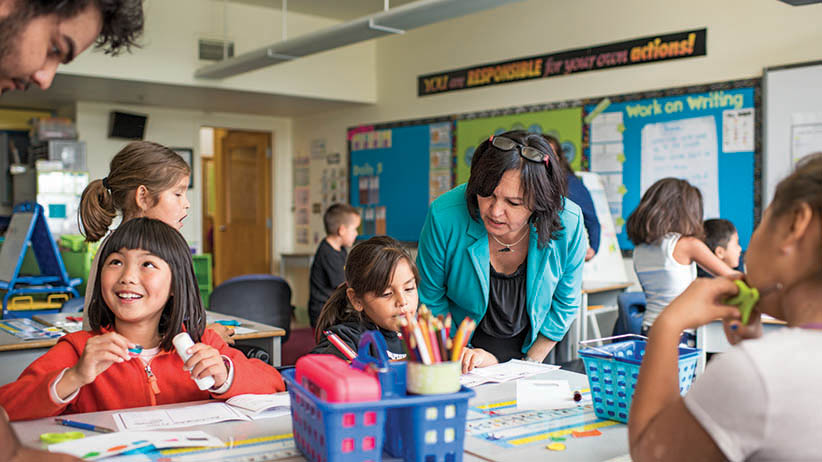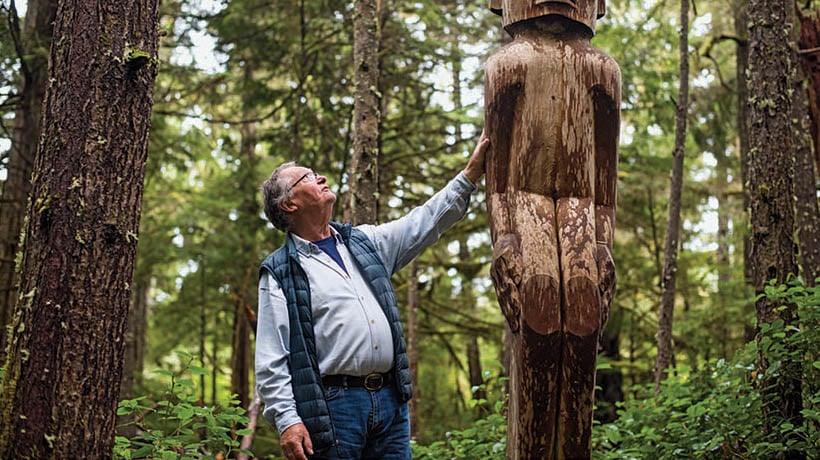Bella Bella, B.C.: The town that solved suicide
How remote Bella Bella emerged from its ‘dark time’ by reconnecting troubled youth with the land
Ms. Wilson’s Grade 1 class takes part in Salmon Week events (2015), learning how to prepare salmon for traditional barbecue around the fire. During Salmon Week, our students get hands-on experience with smoking, barbecuing, drying and jarring salmon. (Johanna Gordon-Walker)
Share

The airport in Bella Bella is a one-room shack with plastic chairs and a resident tabby cat. Last Friday, as gale force winds lashed the windows, she padded across the laps of a dozen foreign tourists outfitted in thousands of dollars in dark Gore-Tex gear before dozing off on one of their backpacks.
The soggy Brits, Germans and Australians packing the remote airport on Campbell Island, on B.C.’s Central Coast, are among an increasing number of tourists flocking to the region. Royalty—Prince William and his wife, Kate, will touch down here next Monday during their Western Canadian tour—and global travellers alike come to see grizzly bears and the rare, cream-coloured Kermode bear up close.
Bella Bella, an Indigenous community of 1,600, sits at the heart of the Great Bear Rainforest, a vast, remote world of uninhabited islands, kelp forests and white sand beaches. People are scarce outside the Heiltsuk community, but in the surrounding forests there is life everywhere, including the highest concentration of grizzly bears on the continent. (B.C.’s fast-growing bear-watching industry is already far outpacing its trophy hunt, generating 12 times more spending in the Great Bear than the hunt, according to a recent study out of Stanford University.)
But change is afoot. Bella Bella’s tiny airport, slated to be overhauled in the months ahead, isn’t the only thing in town undergoing a rebuild. Plans are in the works for a new guest lodge, restaurant and hostel in Bella Bella and a shop that will sell T-shirts, water bottles, scarves, hats and bags adorned in local art. In the coming months, the new airport, a new band store and a new big house will be erected by the band’s construction firm using local wood milled at a millyard the Heiltsuk are in the process of taking over. And there’s talk of extending a cedar boardwalk built for the royal visit to a three-kilometre waterfront loop, linking the harbour with the former town site at McLoughlin Bay.
“Forgive the cliché, but s–t is happening,” says incoming chief operating officer of the Heiltsuk Economic Development Corporation, Dave Jephcott, who oversees a growing economy built around ecotourism, aquaculture and forestry. The development corporation, which also runs a fuel station, fish plant and freighting company, is hoping to put to use the 10,000 megawatts of excess energy being created by a nearby hydro station. That’s enough to power a greenhouse to grow and export medicinal marijuana, a server farm or an ocean ranch to harvest seaweed, clams, geoducks and sea urchin, says Jephcott.

It’s a remarkable turnaround for a place that once had almost no economy, deep social problems and one of the highest youth suicide rates in the country—a staggering one suicide a month. Many who lived through it refer to the period as the “dark time.”
Parents, some of whom had returned to the 10,000-year-old fishing community scarred or broken by residential schools, were distrustful of the school system. Some 98 per cent of kids were failing to graduate, as the fishery, the mainstay of the local economy, began collapsing. Hopelessness grew in step with social problems and alcoholism, says Kelly Brown, director of the Heiltsuk Integrated Resource Management Department.
All that was just 30 years ago. How did the Heiltsuk overcome some of these problems, and could their journey offer insight to other remote communities similarly struggling?
During the suicide crisis, Jan Gladish’s mother moved her and her six siblings out of the community, for fear they might be swallowed up by the despair claiming so many Heiltsuk youth. Bella Bella was also undergoing massive social change back then, she adds; running water had just arrived. Like many, her family only had a few hours of electricity every day. “Too much change came too quickly,” says Gladish, who five years ago returned to Bella Bella to take the job as principal of the Bella Bella Community School after 40 years outside the community.
The start of the turnaround can be traced to Larry Jorgensen, a young, mental health bureaucrat from southern Ontario who arrived in Bella Bella by way of Alberta, where he’d helped reorganize the province’s mental health department. Jorgensen, tasked with creating programs to keep Heiltsuk kids in school, fell in love with the Heiltsuk lands, and ended up selling everything and moving there permanently, eventually marrying into the Heiltsuk.

Jorgensen, seeing how detached Heiltsuk kids had become from their lands, began taking them out into the watershed, building cabins with them, teaching them about the vast territory, which stretches over 17,000 sq. km.
When they’d built 10 cabins, Jorgensen approached provincial justice officials, managing to convince them to allow Heiltsuk youth sentences to be served alone in these cabins, a traditional practice, rather than in detention facilities. Young offenders were forced to chop wood and fend for themselves after being dropped off all alone to serve out their sentences. (Jorgensen and their families would bring them groceries every week, and Jorgensen kept watch on them from afar.)
When Jorgensen first arrived, people in the community used to ask: “Who’s this white guy?” says Louisa Housty, a Heiltsuk community worker. “But Larry was accepted because he was always standing up for the youth. People looked up to him—to his passion.”
For years, Heiltsuk leaders had been searching for ways to get youth back onto the territory, to teach them traditions that were being left behind. “They knew that if the kids stopped caring, they might as well give up,” says Jorgensen. By then, many had stopped going out to seaweed and salmon camps.
In the 1990s, Jorgensen and the Heiltsuk leadership formed the Qqs Projects Society. The non-profit runs Koeye Camp, a summer science and cultural camp for Heiltsuk youth in a river valley about an hour south of Bella Bella by boat. The idea behind Koeye is to take kids out of their comfort zones and into the wild, so they can better understand where they come from. (Qqs, pronounced “kucks,” is the word for “eyes,” in Hailhzaqvla, a Wakashan language.)

Seeing youth flourishing on the land this way, Qqs and Heiltsuk leaders began formulating deals with the myriad universities and global environmental organizations conducting research on Heiltsuk lands. They created a working model: To gain access, visiting marine scientists would agree to spend time (sometimes as much as two weeks) with a group of local youth, teaching them about marine science or coastal mammals. Over time, scientists began hiring Heiltsuk youth to assist with research, teaching them to count the male-to-female ratio in crabs or collect grizzly bear hair snags to send away for genetic analysis.
Heiltsuk elders and leaders decided that on the days that youth were learning about marine life they could spend time in the evening learning the Heiltsuk songs and history of the undersea world. “We needed to get families living once again in ways that reflect the way our ancestors did,” says Kelly.
Over time, Koeye campers became Koeye counsellors; and Koeye graduates began emerging as Heiltsuk cultural and community leaders. Some have returned to Bella Bella armed with science and archeology degrees to help run the Heiltsuk Integrated Resource Management Department. It oversees research, fisheries and forestry projects on Heiltsuk lands. Others have joined the local band council. These days, Qqs, a growing non-profit guided by the Heiltsuk leadership, runs a series of camps, a lodge, café and gift shop, a top-rate community library and a consultancy.
In the last 15 years, the Heiltsuk have taken control of the local health authority, social services, child and family services and resource management. The band’s resource management plan carves out 50 per cent of Heiltsuk territory as a conservancy, safeguarding it from all industrial activity. The remaining 50 per cent is governed by an ecosystem-based management plan, which protects sacred, medicinal and unique sites from logging, mining, fishing and aquaculture projects.
The graduation rate in Bella Bella now tops 85 per cent, according to Gladish, up from just two per cent in the ’70s. There are still youth at risk in the community, but Brown says he can’t remember the last time there was a suicide death by a young person; Jorgensen says it’s been more than 15 years.
The Bella Bella Community School is also playing a big role in the Heiltsuk’s cultural and language revitalization. Last week, during the autumn salmon festival, a smokehouse was set up on school grounds. Each grade was taught a specific skill—how to fillet, smoke, cure, jar or barbecue salmon using traditional methods. At other times, students are taught the names of hereditary chiefs or how to weave cedar, for instance.

In grades 11 and 12, “Literature of the First Peoples” replaces English. Rather than Macbeth or Animal Farm, students read Tomson Highway’s Kiss of the Fur Queen or Thomas King’s The Inconvenient Indian. High school students receive 60 minutes of Hailhzaqvla lessons every day (30 minutes for elementary students). “Language is as important to us as the salmon,” says Brown. “If one goes, our entire culture will be lost.”
The school also has an in-house marine biologist. Johanna Gordon-Walker organizes more than 50 day trips and eight multi-day camping trips over the school year, and oversees the after-school outdoors club for high schoolers. Grade 7 students might spend a day learning to use a salmon weir, a traditional trapping method on the Koeye River. “Kids don’t think of it as learning when they’re outside exploring, but of course it is,” says Gordon-Walker.
The construction and economic development projects are the most visible signs of change in Bella Bella, says Louisa Housty. One of Jephcott’s first acts as COO was putting a stop to the import of vinyl siding from Vancouver Island. Current housing design makes the homes about as cozy as “an ice box,” and encourages the growth of mould in a community that sees 12 months of rain, he says. Going forward, decking, siding, stairs and new homes will be built from local yellow cedar milled at the local yard.
The community is blessed with natural resources that have made such development possible. Not all remote communities—like the Pimicikamak Cree Nation in northern Manitoba, or Attawapiskat, in northern Ontario, both of which underwent youth suicide crises last year—are similarly blessed. But economic development can only do so much. Housty believes the biggest change of the past three decades has been in the hearts and minds of the Heiltsuk. “We have a much better sense of who we are now—in the identity of our territory.”
The almost obsessive focus on Heiltsuk youth continues. Recently, the community opened a new youth centre adjacent to the school. It runs programming 14 hours a day, seven days a week—lunch programs aimed at getting Grade 5 girls talking about friendships, a “dinner and a movie” night aimed at teaching Grade 7 students to cook for themselves, a space for teens to hang out safely after dark.
“We came back,” Brown adds. “It took my entire life. We lived through the darkest of times. We’re not where we want to be. But we’re getting there. Mark my words, we’ll get there yet.”